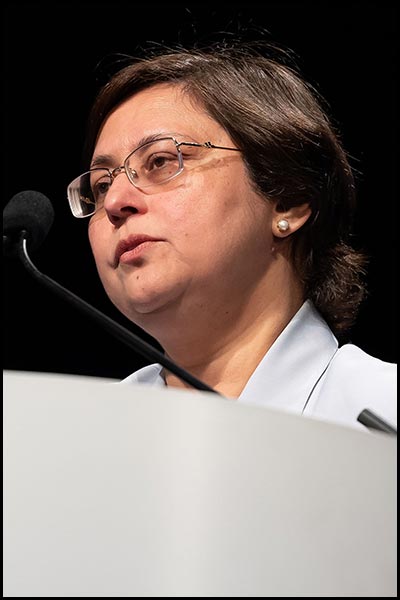Annual Meeting highlights showcased in final plenary session

During the final session of the AACR Annual Meeting 2023, Program Committee Chair Robert H. Vonderheide, MD, DPhil, and three members of the Program Committee reviewed several significant highlights and important themes from the meeting.
AACR Annual Meeting 2023 Highlights: Vision for the Future was presented on Wednesday, April 19, and can be viewed on the virtual meeting platform by registered meeting participants through July 19, 2023.
The Annual Meeting attracted over 21,000 registrants from around the world who participated both in-person and virtually. The meeting program featured 6,300 abstracts and more than 600 oral presentations, as well as a record number of clinical studies, said Vonderheide, Director of the John H. Glick Abramson Cancer Center at the University of Pennsylvania.
“We are all studying the same issue — the pathophysiology of cancer,” he said. “We have made progress and we have a lot more to do. Every voice matters in cancer research and every idea is a good one.”
Clinical research and clinical trials

There were more than 250 clinical trial presentations at the meeting, noted Shivaani Kummar, MD, Co-chair of the AACR Annual Meeting Clinical Trials Committee.
“We saw trials in four key areas this year — immunotherapy moving to early stages and novel combinations; success in targeting genetic abnormalities, particularly DNA damage response and RAS pathways; developing treatments for rare cancers; and bispecifics and novel agents for hematologic malignancies,” said Kummar, the DeArmond Endowed Chair of Cancer Research, Co-director of the Center for Experimental Therapeutics, and Deputy Director for Clinical & Translational Research at the Knight Cancer Institute at Oregon Health & Science University.
Building on earlier results from the CheckMate 816 trial, which illustrated the benefit of neoadjuvant nivolumab plus chemotherapy in patients with non-small cell lung cancer (NSCLC), results from the AEGEAN trial presented at the Annual Meeting found that neoadjuvant durvalumab plus chemotherapy followed by adjuvant durvalumab improved outcomes over neoadjuvant chemotherapy alone.
“After 24 months, we saw improved event-free survival for neoadjuvant durvalumab plus chemotherapy, improved progression-free survival (PFS), and improved major partial response,” Kummar said. “Neoadjuvant immunochemotherapy is here to stay.”
KEYNOTE-942 was the first randomized clinical trial evaluating a neoantigen vaccine with a clinical efficacy endpoint. In the trial, a personalized mRNA cancer vaccine with up to 34 neoantigens in combination with pembrolizumab showed statistically significant and clinically meaningful recurrence-free survival versus pembrolizumab alone in patients with resected, high-risk melanoma.
“We need longer follow-up and a confirmatory trial, but this could present a useful clinical approach for other tumors,” Kummar said.
A phase II trial of durvalumab plus the angiogenesis inhibitor pazopanib in advanced soft tissue sarcomas offered molecular characterization of clinical response. Analysis of pretreatment biopsies revealed tertiary lymphoid structures and elevated B-cell infiltration correlated with better treatment outcomes, Kummar said.
A pair of studies, TRESR and ATTACC, showed positive results combining poly (ADP-ribose) polymerase (PARP) inhibitors with ataxia-telangiectasia and Rad3-related (ATR) inhibition. The hypothesis, Kummar said, is that ATR inhibition would block recovery from PARP inhibitor-induced DNA damage, leading to cell death. The trials evaluated the ATR inhibitor camonsertib in combination with one of three PARP inhibitors — talazoparib, niraparib, or olaparib — in patients with advanced solid tumors harboring DNA damage response alterations. The clinical benefit rates ranged from 41 percent to 59 percent across the three combinations.
“It didn’t matter which PARP inhibitor was chosen as a partner. Benefit was seen across multiple tumors regardless of previous PARP inhibitor treatment or the presence of platinum-resistant tumors,” Kummar said.
The HUDSON trial took a similar approach using durvalumab plus ceralasertib, a first-in-class ATR inhibitor, in NSCLC. The combination significantly improved PFS and overall survival versus other regimens in the trial.
Arm N of the AcSé-ESMART trial used olaparib plus ceralasertib in children with advanced malignancies. There were no differences in the DDR pathway alterations in adults versus children, Kummar noted. Of 18 children, there were two confirmed partial responses, one unconfirmed partial response, and eight patients with stable disease.
“This concept of matching genetic alterations to the treatment is being evaluated in adults and pediatric oncology in multiple trials,” she said.
Multiple presentations focused on the RAS/RAF pathway and the clinical evaluation of new agents to target KRAS G12C, both alone and in combination with checkpoint inhibitors.
A first-in-human study of the investigational KRAS G12C inhibitor LY3537982 showed responses at all dose levels in patients with advanced solid tumors, including those who had received prior treatment with a KRAS G12C inhibitor. Treatment with LY3537982 led to favorable responses in combination with pembrolizumab, and the combination was well tolerated.
A trial of another KRAS G12C inhibitor, GDC-6036, plus the EGFR inhibitor cetuximab in colorectal cancer (CRC) is one of the first combinations to target endothelial growth factor receptor (EGFR) pathways that contribute to CRC progression. Single-agent GDC-6036 had a 31 percent overall response rate (ORR), while the combination of GDC-6036 and cetuximab had an ORR of 62 percent.
“Multiple trials in the space are showing activity, with more to come,” Kummar said.
Researchers also reported progress in rare cancers, which account for about 25 percent of all tumors and are a priority for researchers and public health organizations.
A first-in-class, first-in-human trial of VT3989, an inhibitor of YAP/TEAD in patients with advanced malignant mesothelioma and other solid tumors, showed responses across multiple tumor types.
Results from SWOG S1512 revealed high response rates to single-agent pembrolizumab in patients with unresectable desmoplastic melanoma, including a complete response in 33 percent of patients and an ORR of 89 percent.
A first-in-human study of REGN5459, a bispecific antibody to B-cell maturation antigen and CD3, demonstrated early, deep, and durable anticancer activity with an acceptable safety profile in patients with relapsed/refractory multiple myeloma, including an ORR of 65 percent.
“All of these [trials] put together represent significant steps forward in our ability to improve health outcomes for our patients,” Kummar said.
Basic science and translational research

Sheila A. Stewart, PhD, Professor and Vice Chair of Cell Biology and Physiology and Professor of Medicine at Washington University, reviewed key themes related to basic cancer science and translational research.
“The complexity of tumors was the theme percolating throughout this meeting,” she said. “Therapy follows our discoveries, and personalized therapy requires a holistic understanding of cancer.”
Several Annual Meeting presentations reminded attendees to think beyond conventional thinking, Stewart said. Conventional thinking imagines the tumor microenvironment (TME) as a food desert with T cells and tumor cells competing for the same nutrients. In reality, the TME is more a swamp of metabolic byproducts, she said, and some of these potentially toxic wastes can modulate immune responses.
During the symposium Immunometabolism and Tumor Microenvironment, three researchers explored how metabolic components can impact immune responses and examined strategies that might alter the metabolic landscape to promote antitumor immunity.
Another symposium, Emerging Clinical Strategies for Myeloid Cell Modulation in Cancer, examined new approaches under development to therapeutically target myeloid cells, including strategies to deplete, inhibit, reprogram, or activate myeloid cells. A key take-home message from the session is that sex matters, Stewart said. Sex hormones can modulate antitumor immunity differently in males and females, which can affect immunotherapy response, she said.
Additional topics highlighted by Stewart include the effects of stress, obesity, aging, and the microbiome on cancer; mechanisms of metastasis; comorbidities and cachexia; and tumor evolution; among others.
“[Cancer] is confusing, but we have made great strides and we have wonderful technologies to help us crack this. The future is bright,” Stewart said.
Prevention, early detection, population sciences, and disparities research

Elizabeth A. Platz, ScD, MPH, Professor and the Martin D. Abeloff, MD Scholar in Cancer Prevention at the Johns Hopkins Bloomberg School of Public Health, and Co-Leader in Cancer Prevention and Control at the Sidney Kimmel Comprehensive Cancer Center, reviewed the meeting’s highlights related to prevention, early detection, population sciences, and disparities research.
Population science was covered in three dedicated advances sessions that examined important topics like COVID-19 and cancer, new studies in implementation science and behavioral economics, and the etiology of omics and approaches to better use omics to inform personalized cancer prevention, treatment, and interception in high-risk individuals.
The session Behavioral Economics and Nudges to Improve Cancer Care examined the impact of low-cost, sustainable interventions (or “nudges”) to improve cancer care and outcomes. Pragmatic trials in colorectal cancer screening, precision oncology care, and end-of-life conversations have demonstrated that patient nudges, delivered to the right target at the right time, can change behavior to improve health, said Platz, who is Editor-in-Chief of the AACR journal Cancer Epidemiology, Biomarkers & Prevention.
Another series of advances sessions focused on the science of cancer disparities.
The session Disparities and Cancer Outcomes explored the concept of allostatic load, a measure of cumulative physiological stress and burden across major regulatory systems. The session’s presenters also examined the contributions of genetic ancestry to cancer risk and the potential for alternative therapeutic approaches to improve cancer treatment and survival. Recent disparities research suggests that differences in cancer rates and cancer outcomes in different racial groups have roots in both societal structures and biology, Platz said.
Platz also highlighted the session Novel Approaches to Personalized Cancer Health Equity. Community engagement is key, but not every researcher has that specialized skillset, she noted, adding that hiring community members to serve as consultants could help bridge this gap.
“Think about community members as citizen-scientists. Bring the community members into the science domain so they, too, can participate as scientists in analyzing data that comes from their communities,” said Platz.
Additional topics covered during the meeting and discussed by Platz include cancer interception, risk prediction, the management of hereditary cancers, and the impact of cancer on responses to COVID vaccination.
Platz also mentioned the recently released National Cancer Plan, which provides a framework for everyone — across the federal government and all of society — to collaborate in ending cancer and realize the vision laid out in the Cancer Moonshot. Monica M. Bertagnolli, MD, Director of the National Cancer Institute (NCI), discussed the National Cancer Plan at the Annual Meeting during the NCI Director’s Address and Fireside Chat.
More from the AACR Annual Meeting 2025
View a photo gallery of scenes from Chicago, continue the conversation on social media using the hashtag #AACR25, and read more coverage in AACR Annual Meeting News.

